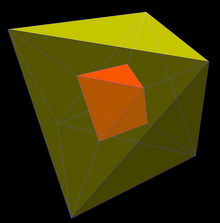|
Octahedral prism
In geometry, an octahedral prism is a convex uniform 4-polytope. This 4-polytope has 10 polyhedral cells: 2 octahedra connected by 8 triangular prisms. Alternative names
CoordinatesIt is a Hanner polytope with vertex coordinates, permuting first 3 coordinates:
StructureThe octahedral prism consists of two octahedra connected to each other via 8 triangular prisms. The triangular prisms are joined to each other via their square faces. Projections The octahedron-first orthographic projection of the octahedral prism into 3D space has an octahedral envelope. The two octahedral cells project onto the entire volume of this envelope, while the 8 triangular prismic cells project onto its 8 triangular faces. The triangular-prism-first orthographic projection of the octahedral prism into 3D space has a hexagonal prismic envelope. The two octahedral cells project onto the two hexagonal faces. One triangular prismic cell projects onto a triangular prism at the center of the envelope, surrounded by the images of 3 other triangular prismic cells to cover the entire volume of the envelope. The remaining four triangular prismic cells are projected onto the entire volume of the envelope as well, in the same arrangement, except with opposite orientation. Related polytopesIt is the second in an infinite series of uniform antiprismatic prisms.
It is one of 18 uniform polyhedral prisms created by using uniform prisms to connect pairs of parallel Platonic solids and Archimedean solids. It is one of four four-dimensional Hanner polytopes; the other three are the tesseract, the 16-cell, and the dual of the octahedral prism (a cubical bipyramid).[1] References
External links
|
||||||||||||||||||||||||||||||||||||||||||||||||||||||||||||||||||||||||||||||||||||
Portal di Ensiklopedia Dunia





















